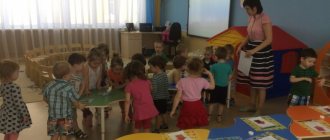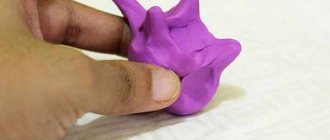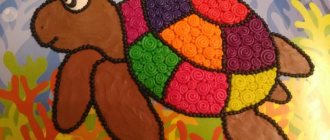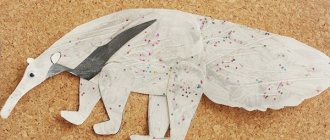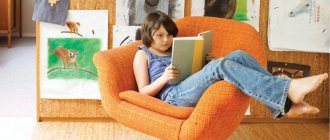Project in the middle design group "Farm"
Municipal autonomous preschool educational institution
general developmental kindergarten No. 51 in Tomsk
Middle group project
"Farm"
Completed by teacher: Shkotova E.A.
Tomsk 2022
Explanatory note
Innovative processes in the education system of the Russian Federation require a new organization of the system as a whole. Particular importance is attached to preschool upbringing and education. One of the main tasks that the Federal State Educational Standard of Preschool Education sets for the teacher is the formation of motivation for the development and learning of a preschooler, as well as the development of creative and cognitive activity. Modern realities present us with the task of raising young engineers. Construction is one of the modern areas of children's development, which has a positive impact on the all-round development of preschoolers. Constructive activity is a powerful means of child mental development. Modern construction sets, the so-called “new generation” construction sets, are a modern, unique means of development, training and education of children, which not only prepares children to study technical sciences, but also develops spatial orientation, the ability to analyze and compare, plan, model, find connections and patterns, develops perception and imaginative thinking, imagination and fantasy, creative abilities, forms the prerequisites for positive motivation for learning at school.
In the process of design classes, work is being done on the development of the intellect of imagination, fine motor skills, creative inclinations, the development of dialogic and monologue speech, and the expansion of vocabulary. Each child participating in the work to complete the proposed task expresses his attitude towards the work performed and talks about the progress of the task. Particular attention is paid to the development of logical and spatial thinking. The designer opens up a new world for the child, provides an opportunity in the process of work to acquire such social qualities as curiosity, activity, independence, responsibility, mutual understanding, skills of productive cooperation, increasing self-esteem through the awareness of “I can do it, I can”, a positive attitude, relieving emotional and muscle tension. The ability to use instructions and drawings, diagrams is developed, and logical, design thinking is formed. During educational activities, children become builders, architects and creators; while playing, they come up with and implement their ideas
Project type:
informational-creative, cognitive-research.
Project type:
— by the number of participants: group;
-in terms of time: short-term.
Period:
25.10.-16.11.2021
Project participants:
children 4-5 years old, parents, teachers.
Problem:
A preschooler feels his connection with the natural world to the fullest: it’s not for nothing that children are drawn to our smaller brothers (dogs, cats; they ask their parents to have pets). Nowadays, children are little familiar with the life of pets, the conditions in which they live, how to care for them, what benefits they bring to humans, how important it is to love and treat them with care. For a modern child, a cow, a ram, a lamb, etc. almost rare animals. In large villages it is very rare to see a cow or a horse now, and there are very few of them left in the villages. Therefore, we decided to introduce children to pets through constructive skills using a modern construction set.
Objective of the project:
to form the simplest ideas about the work of an animal farm through the use of modern construction sets (floor-mounted hollow construction set (“Builder”); desktop wooden construction set (“Builder”, “Town”); LEGO Duplo, Polesie, “Pixels” mini and maxi construction set).
Project objectives:
Educational
:
- consolidate and develop design skills according to a model, condition;
- enrich and activate the vocabulary, improve monologue speech, the ability to compose a story about a subject, describe one’s actions, build a chain of logical and consistent narration, etc.;
- develop the ability to search and transform the necessary information based on various information technologies (graphic - text, drawing, diagram; information and communication);
- develop fine motor skills of the hands, stimulating in the future general speech development and the development of mental abilities.
Educational:
- create conditions for the development of attention, memory, imaginative and spatial thinking;
- promote the development of the child’s creative activity;
- contribute to broadening your horizons and developing ideas about the world around you
Educational:
- to form the prerequisites for educational activities: the ability and desire to work
- carry out tasks in accordance with instructions and the set goal, bring the work started to completion,
Planned result:
- Children will develop an interest in making their own buildings, the ability to apply acquired knowledge when designing and assembling structures, cognitive activity, imagination, fantasy and creative initiative.
- Design skills and abilities will be formed, the ability to analyze an object, highlight its characteristic features, main parts, and establish a connection between their purpose and structure.
- Children’s communication skills are improved when working in pairs, teams, and sharing responsibilities.
- The prerequisites for educational activities will be formed: the ability and desire to work, carry out tasks in accordance with instructions and the set goal, bring the work started to completion, plan future work.
Children will have ideas:
- about the details of the designer and methods of their connections;
- about the stability of models depending on their shape and weight distribution;
- on the dependence of the strength of a structure on the method of connecting its individual elements
- about the relationship between the form of a structure and its functions.
Conditions for project implementation
- Constructors: floor hollow constructor (“Builder”); desktop wooden construction set (“Builder”, “Town”); LEGO Duplo, Polesie, “Pixels” mini and maxi constructor, “large soft constructor”.
- Technical teaching aids: camera
- Demonstration material on the subject of GCD.
- Didactic games to reinforce techniques.
- Technological maps, maps - diagrams of buildings.
- Thematic coloring pages.
Types of work organization:
- design based on a model - when there is a ready-made model of what needs to be built and a plan - when the child himself, without any external restrictions, creates an image of the future structure, and embodies it in the material that is at his disposal. This type of construction develops creative abilities better than others;
- design according to diagrams - this is when ready-made instructions are attached and according to conditions - when there is no sample, only the conditions that the building must meet are set (for example, a house for a dog must be small, and for a horse - large).
Implemented educational areas:
cognitive development, artistic and aesthetic development, social and communicative development, speech development.
Children's activity product:
buildings for pets from different types of construction materials.
Project stages:
| Preparatory Stage Target: determine the main areas of work: -Informing and familiarizing parents with the topic and plan of the project -Collection and accumulation of information about the designer — Prepare visual aids (algorithm of actions and diagrams, instructions and drawings) — Planning of joint activities | Main stage Target: help children collect information about the LEGO constructor. 1. Conversations on topics: "Farm Residents" "Adult Labor on the Farm" 2 Reading works of fiction( K.D. Ushinsky “Carrying Cow”, “Two Little Goats”, “Goat”, K.G. Paustovsky “Friend Tobik”, I.A. Krylov “Pig under the Oak Tree”, Russian folk tales “Bull, Tar Barrel”, “Rock Hill”, “Cat, Rooster and Fox”, “Geese and Swans”, V.V. Bianchi "The Sly Fox and the Smart Duck" Reading nursery rhymes: “Cockerel-cockerel”, “My little pig”, “Jumps, jumps, chok-chok-chok”, “Little kitten”, “Like our cat”. 3. Didactic games “Who lives where?”, “Who eats what?”, “Big - small”, “Who screams how”, 4. Guessing riddles 5. Examination of plot paintings about domestic animals, a farm, buildings on a farm 6. Educational activities: applique, paper design, Lego 7. Creation of an exhibition of works “In the world of animals” At the second stage, children enriched their vocabulary of words; developed dialogic and monologue speech. | The final stage Target: To develop in children the ability to use the acquired knowledge about the designer in games. Ways to solve problems (pets need a home) — work with Lego (construction of buildings and animals from large and small building materials to create a farm and then play with it) Algorithm for working with the constructor: 1. Examination of samples, diagrams, drawings, paintings. 2. Search - selection of the necessary parts from the general set. 3.Assembling parts of the model. Consistent connection of all assembled parts into one whole model. 4. Compare your assembled model with a sample, diagram, drawing, picture. 5. Creation of a laptop on light construction. At the third stage, children got acquainted with different types of Lego construction sets and analyzed the assembled structures. |
Preliminary work:
viewing encyclopedias; illustrations; watching cartoons: “Lessons from Aunt Owl”, “My Pets”, “Prostokvashino”, “How an Old Man Sold a Cow” (at home with parents); “pets” coloring pages, coloring pages for buildings (house, barn, mill, gates, fence, roof, floor, walls, windows), working with Lego sets.
Direct educational activities:
- Drawing “Cat” (using the poking method), constructing “Pets” from bushings, applique “Cow”
- "Introduction to LEGO - designer"
- "Different houses" (buildings on the farm)
- "Dog"
- "Horse"
- "Ducklings in the Lake"
- "Let's build a corral for a cow"
- "Farmer's House"
- "Chicks"
Conclusion:
Construction is one of the favorite types of children's activities. A distinctive feature of such activities is independence and creativity. As a rule, construction ends with play activity. Children use LEGO buildings in theatrical games;
- in story games;
- in experimentation;
- use LEGO elements in didactic games and exercises;
- in preparation for learning to read and write; - getting to know the world around you;
- in cognition and other activities;
As a result, systematic observations and conversations showed that after the work, an emotionally positive attitude towards natural objects began to predominate in children. Work on the project contributed to the development of children’s thinking, memory, speech, horizons, interest in the world around them, and the development of love and respect for nature. Thus, the interaction and communication of all project participants: teachers, children and parents, united by one problem, allowed us to achieve positive results:
1) children developed an interest in representatives of the animal world;
2) there was a desire to communicate with nature;
3) children have learned the norms and rules of interaction with the outside world;
4) learned to treat animals with care and concern;
5) preschoolers’ vocabulary has significantly expanded;
6) children show a stable positive interest in constructive activities,
7) know the name of the design parts, methods of their fastening,
 know how to select parts necessary for design;
know how to select parts necessary for design;
9) acquired practical skills and design skills according to a scheme, drawing, model, theme, plan;
10) created a game corner “Farm”.
When implementing this short-term project, we encountered problems:
| Difficulties and risks of the project | Ways to eliminate project difficulties and risks |
| Insufficient initial equipment of preschool educational institutions with designers | Clear planning of procurement activities. Gradual expansion of the design base |
| Insufficient methodological support on this topic. | Development of methodological support for the implementation of classes in technical design and robotics. Active use of Internet resources. |
| Lack of interest in technical design and robotics on the part of parents. | Intensifying the activities of parents through active forms of interaction (master classes, open classes, consultations), systematically informing about the success of children in the field of technical design. |
Bibliography
1. Komarova L.G. We build from LEGO "LINK-PRESS" - Moscow, 2001.
2. Luss T.V. Formation of skills in constructive play activities in children using LEGO. – Moscow: Humanitarian Publishing Center VLADOS, 2003.
3. L.G. Komarova Building with LEGO (modeling of logical relationships and real-world objects using LEGO construction kits). – M.: “LINKA – PRESS”, 2001.
4. Paramonova L.A. Children's creative design - Moscow: Publishing house "Karapuz", 1999.
5. Feshina E.V. “Lego construction in kindergarten” A manual for teachers. – M.: ed. Sphere, 2011.
6. Ishmakova M.S. Design in preschool education under the conditions of the introduction of the Federal State Educational Standard All-Russian Educational and Methodological Center for Educational Robotics. – M.: Publishing house-polygraph, 2013.
Application.
Board-printed games
Paper construction
Application "Cow"
Construction from different types of constructor
Working with a laptop
Zadachi:
Teach children to fold paper in different directions, giving it the shape of a dog.
Continue to improve children's skills to make correct, clear folds, and fold a square diagonally.
Strengthen the technique of performing the basic form “simple triangle”,
consolidate the ability to use the tearing technique when decorating crafts.
Expand knowledge about the world around us, that people need friends.
Develop imagination, creativity, and ingenuity.
Develop fine motor skills of hands in the process of work,
continue work on audio automation L.
Cultivate accuracy in work and love for pets.
Material : square sheets of paper 10x10 cm in two colors: white and brown, black and white paper, scissors, glue, brushes, dog toy, basket, clothespins, hearts.
Preliminary work: reading stories, poems, asking riddles, looking at illustrations, encyclopedias.
Integration: NGO “Cognition”, NGO “Artistic Creativity”.
Methodology: communicative, activity-based, problem-search.
GCD move:
Q : Children, what time of year is it now? (Winter)
V - l: Let's speak a pure phrase, emphasizing the sound L in our voice. Everything is white, white, white.
There was a lot of snow.
These are fun days -
All on skis and skates.
V— l: The day has come. I will smile at you, you will smile at me, and smile at each other and think: how good it is that we are here together today. We are calm and kind, friendly and affectionate. We are healthy.
Q : Take a deep breath and with a sigh forget yesterday’s grievances, anger, and anxiety. Breathe out of yourself the freshness and beauty of white snow, the warmth of the sun's rays, the purity of rivers, the love of animals.
Q : Children, do you have pets? Do you play with them? (Yes)
V - l: And today an unusual guest came to us, he is very sad, because he has no one to play with. Guess who it is?
Lies - silent:
If you come up, we’ll grumble. Who goes to the owner; She lets you know.
Vs : That's right, it's a dog. Look how sad she is. How can we help our guest? (Play)
V - l: But he will go home and will be left alone again. How else can we help him?
Children : He needs friends.
V - l: Yes, that's right. One is not bored when there are many friends.
V— l: Look what a friend I made to our guest. He is beautiful, like a real dog. Do you want to learn how to make one? (Yes). Now I will teach you how to make a paper dog.
V - l: Get comfortable around me and watch carefully how I will do the dog and learn.
Q : Let’s take a sheet of paper to work with. What shape is it? (square).
Q : I bend our square diagonally in half, matching the corners and sides, and smooth the fold line well with my finger. What line is this? (this is the fold line).
Q : What shape did our leaf become? (Triangular). Mark the middle of the large side by folding the top corners and pinching the fold point. What is this point called? (bending point).
In - l : Place your finger at the bend point, bend the upper right corner down - forward. We do the same with a different angle. Let's turn our craft over. We bend the top corner down towards ourselves, holding the sheet of paper with the other hand. Bend the bottom corner up. What did we get? (muzzle).
V - l: Now I will show you how to make the torso. Take a piece of paper and make a “basic triangle” out of it. What triangle? (basic) How do we do it? (fold the sheet diagonally).
B - L: Bend the lower right corner to the left to the middle, put a finger and bend it back. What happened? (torso). We glue them together. So I got a dog. But is she missing something? What? (eye, nose, mouth). You will do this yourself.
V— l: You looked and listened to me for a long time and were probably very tired. Let's take a little rest.
Physical education for a minute.
Once - bend over, straighten up. Two - bend down, stretch.
Three - clap your hands three times. Three nods of the head.
Four arms wider Five, six - sit down quietly.
V— l: Now, now you try to make the dogs yourself. Come in and sit at the tables. You have papers of different colors. Think about it and choose what kind of dog you will make: white with black spots - a Dalmatian; or brown with white spots - St. Bernard. So, everything is clear to you, you remember everything. But before you get started, let's stretch your fingers.
Finger gymnastics.
On a visit to the big toe, They came straight to the house:
Index and middle, Nameless and last Himself, little finger - baby, Knocked on the door. Together fingers are friends. They cannot live without each other.
Q : Do you remember what I did at first? What then? What we got.
V - l: Let's now glue the dogs to a clothespin and put them in the basket next to our guest.
V - l : Children, look how you turned out? Which dog did you like the most and why? Now I will give you hearts, and you will glue them to the dog you liked.
V— l: Well, we’ll end our lesson on a cheerful note, with the song “Friendship.”
Summary of the design lesson “How we build houses for pets”
Main part. Introduction to the topic of the lesson.
The teacher suggests paying attention to the screen.
A presentation of “architecture” is shown on the screen. The teacher, together with the children, comment on photographs of buildings projected on the screen, noting the materials, beauty and unusualness of the structures.
A slide with a picture of a kindergarten appears on the screen. Children recognize the building. Together with the teacher, they describe the external and internal structure of the building.
Educator:
What is a kindergarten? (this is a house for the guys) Why was it built? (for children to play, study, eat, sleep, draw, dance here) What is the difference between a kindergarten and a house where pets live? (comfortable, beautiful, cozy)
Slides with images of animal dwellings appear on the screen, the teacher clarifies the names of the buildings and the names of the animals living in these buildings, and together with the children note the strength and safety of the structures.
Goal setting and activity planning.
A video of the appeal of Lego men is shown on the screen. “We traveled around the Perm region and saw animals grazing in meadows and fields, they probably have no shelter, who can help them?”
Educator:
Do you want to help them? (yes) Now I suggest you play architects. To play, you need to divide into teams using stickers and occupy your tables with construction sets based on color and receive a task to build houses for animals together. The hardest part will be designing the animal. Can you handle it? (yes) Then choose stickers and go to your tables.
Children are divided into teams of 4 people and take seats at the tables.
Educator:
Before we start, please tell me what we will do?
Children describe the sequence of actions, open envelopes with diagrams of animals, an illustration of a building, and construct homes for pets.
Work in groups.
During the activity, the teacher checks whether the building has windows and whether the animal will pass through the doors. The teacher plays the role of a tutor, advises children, and helps solve difficulties.
Children say they are ready and play with the building with animals.
When the children finish constructing the buildings, the teacher invites the children to come to the table of one of the teams.
Project protection
The teacher invites the children to tell what they did, why they built the building and what it is called. He asks if they succeeded in what they had in mind. Children evaluate their work and conclude that everyone completed the task. Children also take turns moving from table to table.
Reflection.
The teacher draws attention to the screen where Lego men say words of gratitude to the children for their help.
